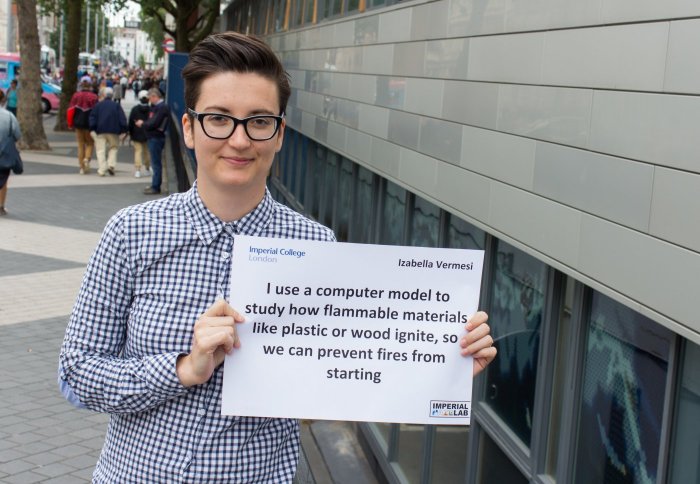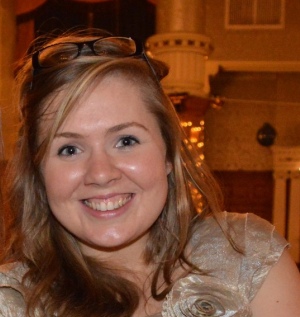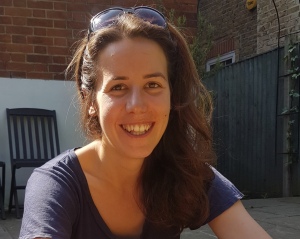INWED 2017: Meet a few of the female engineers in our department

Izabella Vermesi
International Women in Engineering Day (23 June) is a campaign that celebrates the achievements of women engineers.
On the occasion of this year’s INWED, a few of the young researchers in the Department of Mechanical Engineering tell us what their work is about, how they chose a career in engineering, and what they do in their spare time:
Alessandra Ciniero, Research Fellow, Tribology

Alessandra Ciniero
Alessandra has just completed her ESPRC-funded PhD, but she will continue her work at Imperial: “The focus of my research project was the study of the Triboemission phenomenon, i.e. electrons and ions emissions generated by rubbing surfaces. I’m now transitioning into Molecular Dynamics, thanks to a EPSRC Doctoral Prize Fellowship Award, which is allowing me to continue my study in Tribology under the guidance of Professor Dini. My current research tool is a hybrid experimental and computational approach. I use experiments as ground truth for the validation of my models. For this reason, I always like to improve my equipment with new tools and features. This is now possible thanks to the Taiho Kogyo Tribology Research Foundation, which has recently awarded me with a small grant for new equipment. I am really excited and looking forward to it!
My interest in engineering dates back to my childhood, when I used to fix all kind of broken devices around the house. The positive experiences that I earned during my university studies enhanced my desire to continue pursuing my engineering path. I chose to carry out my PhD in Tribology for two main reasons: 1) I believe Tribology is one of the most interesting topics in Engineering; 2) the number of women in the Imperial Tribology group is equal to the number of men, which is rare in a mechanical engineering environment.
I love art, traveling and photography. And, in order to develop these hobbies of mine, I have recently started a travel blog based on instant film photography (@polaroid_travelart on instagram).”
Shirley Echendu, Research Associate, SOFT SOLIDS

Shirley Echendu
“I am working on an industrial research project focusing on the characterisation of viscoelastic behaviour of selected dough samples and simulation of rolling/sheeting process. My principal research interests lie in the area of computational rheology and computational meteorology, mechanical characterisation and material modelling, Design and Simulation of process applications through Computer aided engineering (CAE) and Finite Element Analysis (FEA). I have developed a portfolio of internationally peer-reviewed journal papers in these areas.”
Shirley’s interest in Engineering developed from a young age, and it was later crowned with groundbreaking success: “Being a British-Nigerian born in 1988, I became the youngest ever PhD holder in Eastern Nigeria and one of the top 5 Nigeria’s youngest PhD holders.
Outside of research work, I like to interact with people to help and support in any little way possible. I’m member of a worldwide volunteer service NGO for business and professional women who work to improve the lives of women and girls, in local communities and throughout the world, and we advocate for equality, peace and international goodwill for women. My community service program last year provided food and clothing for orphans and motherless babies.”
Eloise Matheson, PhD student, MECHATRONICS IN MEDICINE

Eloise Matheson
“My research is focused on developing the control and interface for a flexible, robotic needle which is capable of 3D steering in the brain for neurosurgical applications. Under the EU H2020 EDEN name, this project aims to dramatically enhance the current capabilities of neurosurgical needle insertions. The system will use both visual and haptic feedback to help the surgeon guide the needle along the desired path.
Previously I was working as a telerobotics engineer in the field of space robotics in the Netherlands. I’ve always been interested in engineering and understanding how the world around us works. In space robotics, the motivation is to explore the outside world, for medical robotics, it is to better understand ourselves.
Outside of the lab, I’m still keeping up with space research by trying to be involved in small projects. I also enjoy running, basketball and generally spending time with friends and family! I grew up in Australia, so I love to be outdoors whenever I can.”
Marlene Pinzi, PhD student, Mechatronics in Medicine

Marlene Pinzi
Like Eloise, Marlene also works on the EDEN2020 project, which aims to develop an innovative neurosurgical robot with a bio-inspired, steerable needle for targeted drug delivery in cancer therapy. Her research “will focus on the real-time path planning for the catheter, with the objective of generating optimal paths that comply with both the needle mechanical constraints and the needs of the neurosurgeon. “ The path should be adjustable in real time, applying new information on how obstacles have moved due to deformation of the brain tissue.
“I never had a particular vocation for engineering, but I knew since I was a kid that science really interested me. I made the decision to become a biomedical engineer after high school, when I was struggling to understand what would be the best choice for my future. I wanted something related to medicine which would allow me to help people, particularly cancer patients, but I didn’t want to become a doctor. It’s exciting to think about how much we still have to discover and invent. Knowledge has no boundaries and the potential we have on our hands is unlimited.
During my spare time I enjoy sports such as horse riding and fitness. I also have a keen interest in travelling and photography. I never leave without my camera, and I am currently attending a course which will allow me to develop my first photography project.”
Naomi Shipway, EngD student, NON-DESTRUCTIVE EVALUATION

Naomi Shipway
I always enjoyed Maths and Physics far more than any other subjects. I didn’t really know anything about engineering and so it wasn’t until my brother, who was studying Mechanical Engineering at the time, showed me some of the things he was doing, that I really began to consider pursuing engineering.
My first exposure to Non-Destructive Testing was during my undergraduate final year project. My project was performing Ultrasonic Testing of failed water pipe joints. After working for a year as a Process Engineer for a Materials Handling company I began the Engineering Doctorate scheme run by the Research Centre for NDE (RCNDE). My project is automating defect detection for Fluorescent Penetrant Inspection for the aerospace industry. I am currently based at my sponsor company Rolls-Royce plc.
Outside of work, I enjoy socialising with friends and sailing (when the weather allows it!)”
Sina Stapelfeldt, Research Associate, DYNAMICS

Sina Stapelfeldt
“My research focuses on modelling the air flow through jet engines and its interactions with vibrating components. Understanding and being able to prevent the interaction between the flow and the vibration allows manufacturers to develop safer and greener engines. I first studied Engineering because I enjoyed Mathematics and Physics at school and I wanted to apply my skills to solve real-world problems. A summer research project at university then raised my interest in jet engines and I chose to work in this field because I believe that contributing to their improvement is a worthwhile endeavour.
Outside of my research, I like to do sports, am a keen sailor and spend a lot of time fixing dinghies at a local sailing club.”
Izabella Vermesi, PhD student, IMPERIAL HAZELAB
 “I use a computer model to study how flammable materials like plastic and wood ignite, to prevent fires from starting. I run lots of fire simulations and analyse the results in order to evaluate if the current values used in engineering applications are appropriate.
“I use a computer model to study how flammable materials like plastic and wood ignite, to prevent fires from starting. I run lots of fire simulations and analyse the results in order to evaluate if the current values used in engineering applications are appropriate.
I became interested in engineering after developing a fascination with bridges, tunnels and the built environment. This prompted me to become a civil engineer. Then during my MSc course at the Technical University of Denmark, I had a Fire Safety in Buildings class, which opened my eyes to a field I had not considered before. After attending a talk by one of the world leading fire safety experts, I became passionate about fire safety science, so I decided to pursue a PhD in this field. I think fire is one of the most fascinating phenomena in the world and I particularly enjoy reading articles about fire forensics. I still love bridges, but fire is more interesting!
Outside of my research, I enjoy playing video games and board games, my favorite video game being the Mass Effect series. Another passion of mine is going to concerts and music festivals and I make sure I attend a music festival every summer, with other gigs scattered throughout the year. “
National Women in Engineering Day was set up by the Women’s Engineering Society (WES) in 2014, and it was expanded to an international scope this year.
Article text (excluding photos or graphics) © Imperial College London.
Photos and graphics subject to third party copyright used with permission or © Imperial College London.
Reporter
Press Office
Communications and Public Affairs
- Email: press.office@imperial.ac.uk
